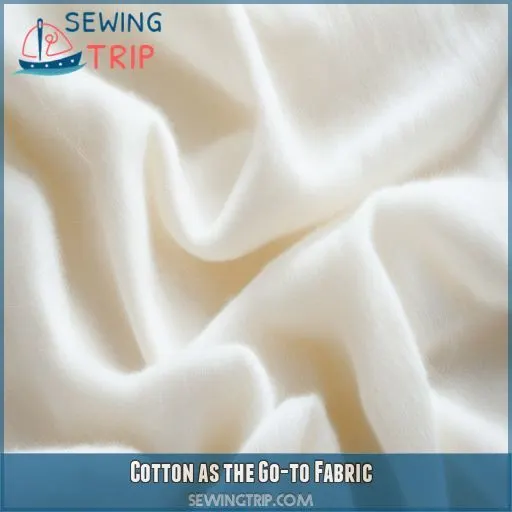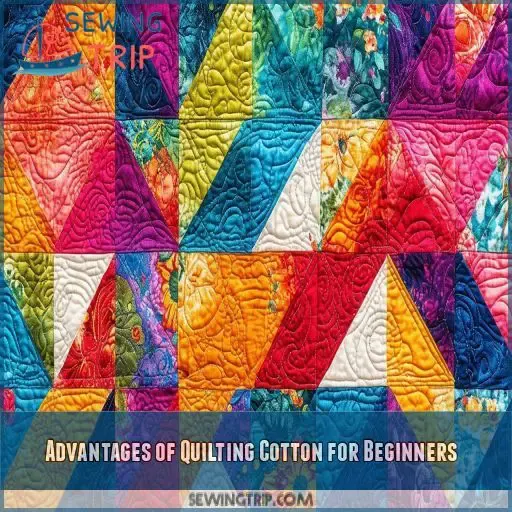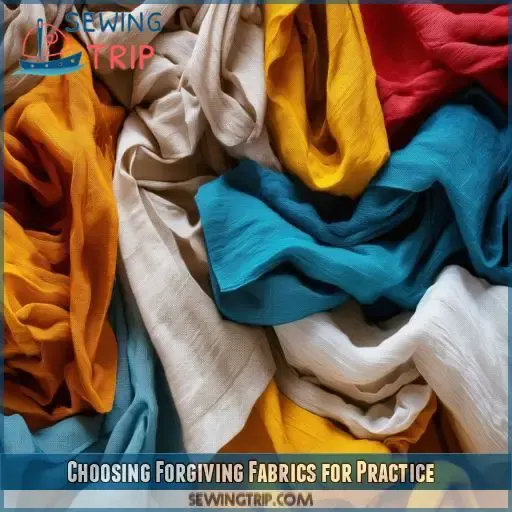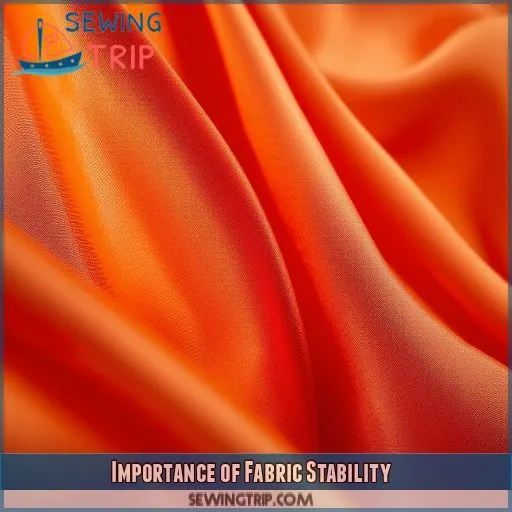This site is supported by our readers. We may earn a commission, at no cost to you, if you purchase through links.
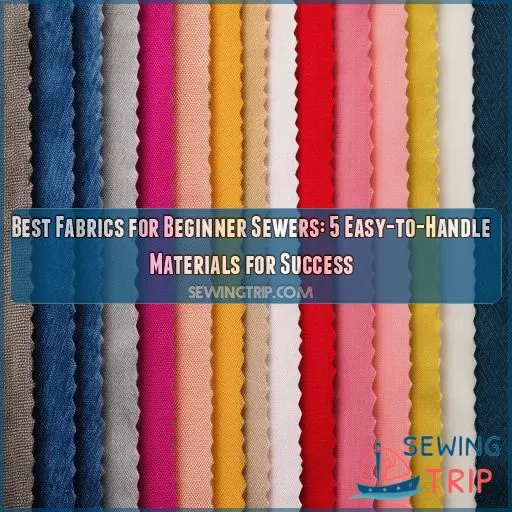
This guide presents you with the most suitable fabrics for beginner sewers, emphasizing five easy-to-handle materials that’ll set you up for success.
From versatile cotton to stretchy knits, you’ll discover fabrics that’ll boost your confidence and skills.
Let’s explore these beginner-friendly options and get you started on your sewing adventure!
Table Of Contents
Key Takeaways
- Cotton is your sewing BFF – it’s like training wheels for your needle and thread adventures! Easy to handle, forgiving of "oops" moments, and versatile enough to tackle everything from breezy sundresses to sturdy tote bags.
- Quilting cotton: the Goldilocks of fabrics – not too slippery, not too stubborn, just right for beginners! With its stable personality and a smorgasbord of colors and patterns, it’s perfect for letting your creativity run wild without running into frustration.
- Linen and lightweight denim: your ticket to the big leagues! Once you’ve got your sea legs (or should we say "sew legs"?), these fabrics offer a delightful challenge. They’re like the cool older siblings of cotton – a bit more sophisticated but still totally approachable.
- Fabric stability is your secret weapon – think of it as the superhero cape for your sewing projects! Opt for materials that hold their shape and won’t leave you in a tangled mess. Remember, even Batman started with training wheels before he could swing from buildings!
Cotton as the Go-to Fabric
When you’re just starting your sewing journey, cotton is your best friend. This versatile fabric is a go-to for beginners, and for good reason. Cotton’s properties make it incredibly easy to work with, giving you a solid foundation as you learn the ropes.
You’ll love its breathability, which keeps you comfortable while you’re hunched over your machine. The softness of cotton is forgiving on your hands, especially during long sewing sessions.
Don’t worry about wear and tear – cotton’s durability means your creations will stand the test of time. From lightweight voiles to sturdy twills, cotton’s versatility lets you tackle a wide range of projects.
As you gain confidence, you’ll find cotton adapts to your growing skills. It’s like having a patient teacher by your side, guiding you through each stitch.
Advantages of Quilting Cotton for Beginners
When you’re starting your sewing journey, quilting cotton is your trusty sidekick. It’s stable, easy to handle, and comes in a rainbow of colors and fabric designs. You’ll find it’s a breeze to cut, pin, and sew, making it perfect for beginner patterns. Quilting cotton holds its shape well, so you won’t wrestle with slippery fabrics as you learn.
From small projects to full quilt sizes, this versatile fabric has you covered. It’s also forgiving regarding washing techniques – toss it in the machine without fear! As you explore color selection, you’ll discover endless possibilities for creativity.
Transitioning to Linen and Lightweight Denim
Once you’ve mastered quilting cotton, it’s time to expand your horizons with linen and lightweight denim. These fabrics offer unique qualities that’ll elevate your sewing game.
Linen’s breathability makes it perfect for summer garments, while its natural drape creates effortlessly chic looks. Don’t fret about wrinkles – they’re part of linen’s charm and add character to your creations.
As for lightweight denim, you’ll love its durability and versatility. It’s sturdy enough for structured pieces yet soft enough for everyday wear. The opacity of denim allows for bold designs without the need for lining.
While these fabrics may seem intimidating at first, they’re actually quite forgiving. With a bit of practice, you’ll be whipping up linen dresses and denim jackets in no time.
Choosing Forgiving Fabrics for Practice
When choosing fabrics for your first sewing projects, you’ll want to focus on materials that are easy to work with and forgiving of mistakes. Cotton, knits, and linen are excellent options for beginners, offering a range of textures and properties that make them ideal for practicing your sewing skills.
Cotton For Easy Handling
As you gain confidence, you’ll find cotton remains a reliable choice. Its easy handling makes it perfect for honing your skills.
Cotton’s fabric drape is predictable, allowing you to focus on technique. It’s colorfast, breathable, and often wrinkle-resistant, depending on the blend.
Always check care instructions, but generally, cotton’s forgiving nature means you can iron out mistakes – literally and figuratively!
Knits With Stretch Properties
When you’re ready to explore beyond cotton, knits offer a forgiving option. Their stretch properties make them easier to fit and more comfortable to wear.
Look for stable knits with good stretch recovery to maintain shape. Consider fabric drape and choose the right weight for your project.
Adjust your stitch length and interfacing needs accordingly.
You’ll find knits open up a world of new sewing possibilities.
Linens Beginner-Friendly Texture
Linen’s beginner-friendly texture makes it a great fabric to explore. You’ll love its natural draping and how it softens with wear. Don’t fret about wrinkles; they’re part of linen’s charm! With a wide range of color options, you can let your creativity shine. Here’s why linen’s a smart choice:
- Forgiving nature for newbies
- Breathable and comfortable
- Durable for long-lasting projects
- Easy to cut and sew
- Versatile for various garments
Importance of Fabric Stability
When you’re just starting out, fabric stability is your secret weapon. Stable fabrics hold their shape, making your sewing journey smoother and more rewarding. You’ll want to steer clear of fabrics prone to bias stretching, seam slippage, or fabric distortion. These tricky materials can turn your project into a frustrating puzzle.
Instead, opt for fabrics that play nice with beginners. Look for those that resist fraying edges and maintain their shape after washing. This way, you won’t be fighting shrinkage or unexpected changes in your finished piece.
Stable fabrics are like training wheels for your sewing skills. They’ll help you master basic techniques without the added challenge of unruly materials. As you gain confidence, you can gradually tackle more adventurous fabrics. Remember, every pro started somewhere – and stable fabrics are the perfect launchpad for your sewing success!
Frequently Asked Questions (FAQs)
What sewing machine settings work best for different fabrics?
Imagine your sewing machine as a versatile Swiss Army knife. You’ll adjust tension and stitch length for different fabrics. For delicates, loosen tension and shorten stitches. With heavy fabrics, increase tension and lengthen stitches. Practice makes perfect!
How to properly pre-wash and prepare fabric before sewing?
You’ll want to pre-wash your fabric the same way you’ll care for the finished garment. Use warm water and detergent, then dry thoroughly. Iron out wrinkles and square up the edges before cutting your pattern pieces.
Which needle types are suitable for various fabric weights?
Threading the needle of success, you’ll find universal needles dance with lightweight fabrics, while ballpoint needles waltz with knits. For denim’s heavy embrace, opt for jeans needles. Sharps pierce delicate silks, and leather needles tame tough hides.
What interfacing options should beginners consider for different projects?
You’ll want to explore fusible and sew-in interfacings. For beginners, fusible’s your go-to. It’s easy to use and comes in different weights. Consider lightweight for delicate fabrics and medium-weight for sturdier projects. Don’t forget non-woven options!
How to identify fabric grain and why is it important?
You’re in for a treat! Fabric grain runs parallel to selvages. Identify it by stretching fabric; less stretch indicates grain line. It’s essential for proper drape, fit, and alignment of patterns. Cutting against the grain can ruin your project.
Conclusion
Beginning your sewing journey is like planting a garden – you’ll need the right soil to nurture your skills. The best fabrics for beginner sewers are your fertile ground.
Cotton, quilting cotton, linen, lightweight denim, and knits offer the stability and forgiveness you need to grow. As you practice with these materials, you’ll build confidence and develop essential techniques.

